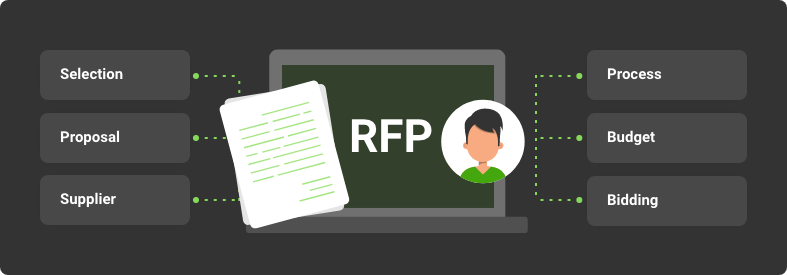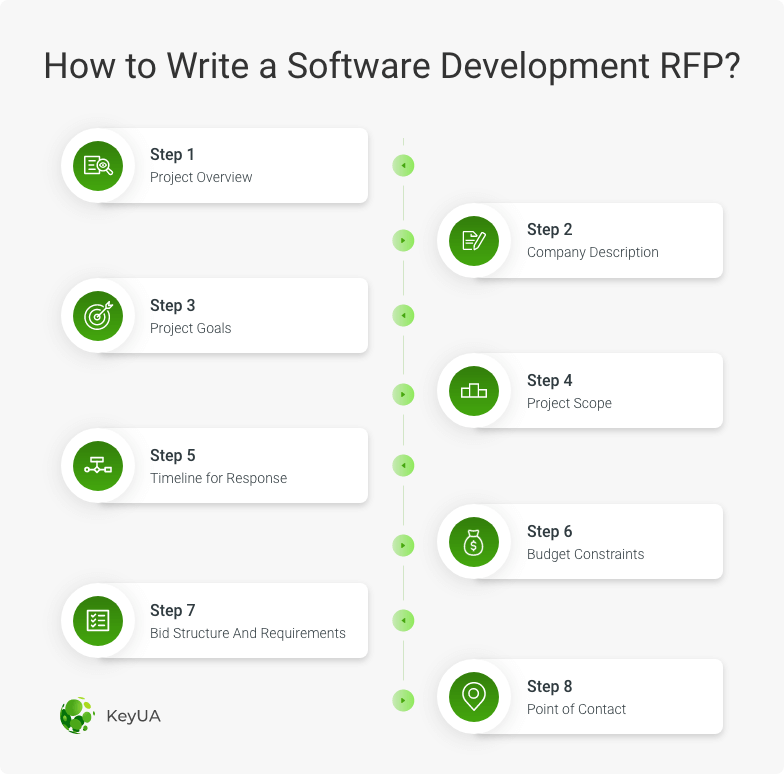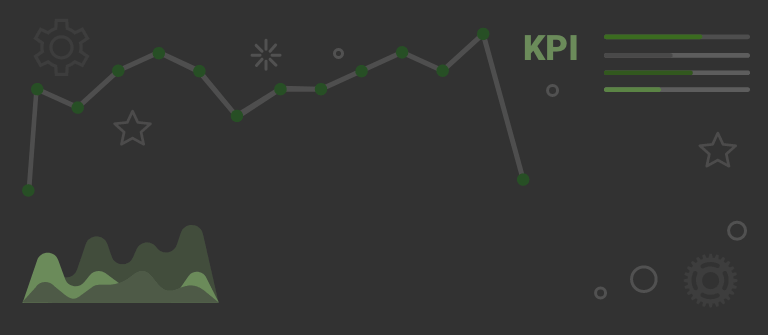Choosing the right contractor for software development highly depends on how well you’ve prepared for the selection process. Composing a detailed, properly thought-out request for proposal (RFP) makes it much easier to narrow down vendor choices to the companies most capable of fulfilling your specific requirements. Here is a step-by-step tutorial with live samples for each document section to give you a clear idea of how to write an RFP for software development.
What is RFP?
RFP (a request for proposal) is a document that outlines all the project specifics for potential vendors. This detailed project description contains the project goal, technical requirements, work scope, budget, and other characteristics. RFP is issued to get bids for the project fulfillment from potential service providers. If your company has some project that you’d like to outsource to another company, an RFP can help you find a suitable vendor and get the job done correctly and on time.
Why is RFP for Software Development a Must?

In software creation, clear and transparent project specs are important for optimizing the project development time and budget. Clients are always interested in obtaining the desired results asap. Software development providers aim to deliver a product that satisfies the client. RFPs, help to transmit your understanding of the requirements for a project to vendors. It is not only a rough project plan. It also clarifies your goals, requirements for the development process, and communication with your potential contractor. This document is like a bridge between the client’s expectations and the supplier’s capabilities. Here is a list of significant benefits of RFP for both parties:
- RFP helps to streamline the search and selection process for a worthy software development company.
- RFP helps to uncover the strengths and weaknesses of potential vendors without spending too much of your time.
- It speeds up the negotiation process and helps to choose the right tools for development.
- It helps to optimize the development time and budget.
- It provides vendors with equal opportunities to win a project and stimulates healthy competition.
There are two ways to find a contractor: spend your own time to find one or use RFP to get vendors to come to you with their proposals. The second approach is more effective, agree?
Looking for a licensed software development provider for your next project? Hire the best specialists from KeyUA.
Get In TouchHow to Write a Software Development RFP?
To let potential bidders submit their proposals (bids), a company requesting the work should draft an RFP. It is also good for getting proposals with equal information inside. You can clearly state your bidding requirements to get everything you need from a provider to make your choice. While it may seem challenging, this tutorial will help you collect and structure all required information correctly. Let’s do it step-by-step using the tips below.

How to Write an RFP for Software Development [Step-by-step]
Step 1. Project Overview
It is a short introduction that gives a vendor a clear idea of what your RFP is about. By reading the project overview, potential contractors should understand if they can do your project and if it is worth placing a bid. Usually, it takes 1 to 3 sentences to formulate the main idea of the project.
Sample:
Company A is seeking a software developer contractor for creating an eCommerce web application to provide a convenient, fault-tolerant platform for processing online orders and providing timely customer support.
Step 2. Company Description
As with any other document section, here you should list only the valuable information for potential vendors. Give a short introduction of what your company does, your current position on the market, and your target audience. Depending on the project, you can specify other details that are related to the current project.
Sample:
Company A is a US-based clothes manufacturer specialized in producing hypoallergenic clothes made of natural eco-friendly materials. The company produces clothes for all age categories and genders. Founded in 2020, the company successfully sold its products via Instagram. It has grown to one of the TOP 3 brands in the niche and faces the need to create a web application to streamline online sales processes and extend its market presence. Most customers are people allergic to synthetic fabrics or those who prefer wearing eco-friendly clothes.
Step 3. Project Goals
List the goals you’d like to accomplish with this project. These can include improving some quantitative results, implementing new features, developing a platform for executing some business process, etc. It would be better to structure your goals in a list.
Sample:
Project Goals.
- Handy e-store for customers to place orders online
- Chatbot for 24/7 online customer support
- Comprehensive administration tool for updating the online product catalog
- A built-in customer analytics tool
- Personalized content for registered customers.
Step 4. Project Scope
It is the most significant part of the custom software development RFP that describes the scope of work you expect from a vendor. It is not a project specs document, so you shouldn’t detail every tiny feature you’d like done. However, the provided information should be enough for developers to understand the required deliverables and weigh if they can manage them in the stated time frame. There are no universal RFP template software projects that perfectly fit all. Here you should list all the services you’re going to hire a team for.
For an e-commerce project, describe the following points:
- Project infrastructure requirements: critical requirements for software and hardware infrastructure to ensure project security on all development stages.
- Functional design: list all the features that need to be developed. Be clear with your requirements for back-end and front-end development.
- Project stages: it is a project development plan with the timeframe for each stage defined. List what part of the project should be completed at each stage.
- Project management: mention what PM methodology you prefer and whether management services will be provided on the vendor's side or by your company. Describe in what way you’d like to receive reports on the work done.
- Testing and QA: you can either do it on your side or request these services from an IT vendor. In both options, describe your expectations to be clear about what deliverables you’d like to get by the end of your contract.
Take your time and thoroughly detail your project scope to avoid any blind spots in your requirements. This section may optionally contain any other information about additional services you need from the development services provider. For example, this can be visual design, UI/UX design, content strategy, copywriting, online marketing strategy, search engine optimization, etc.
Step 5. Timeline for Response
As a rule, a company sets a specific timeframe for bidders to submit their response to the RFP. After this term expires, the submissions are no longer accepted. In this section, you can define the terms for various stages:
- Deadline for submissions
- Deadlines for considering bids and selecting potential contractors
- The dates of final interviews
- The dates for final vendor selection
Informing bidders of your time frame ensures they will be able to meet your deadlines. Provide enough time for software vendors to analyze your project requirements and prepare accurate quotations. The RFP format for software projects implies setting the timeline in both table or plain text form.
Sample:
Collecting bids from potential vendors and shortlisting the candidates is performed within the following deadlines:
Stage Deadline Accepting bids May 1st, 2021 Reviewing bids May 30th, 2021 Shortlisting candidates for interviews June 10th, 2021 Final interviews June 21st, 2021 Vendor selection June 25th, 2021 Project Start July 1st, 2021
Step 6. Budget Constraints
When issuing an RFP, you can either have the budget already set out or have no defined project cost. Either way, describe your expectations in this section. You can list the final project cost or list the budget for each development stage. Often companies expect bidders to propose their own budget quotation according to the detailed project description and then choose a vendor with the most suitable offer. Sometimes the hiring company excludes this section from the RFP. However, we recommend clearly stating your project cost expectations to avoid misunderstandings and bids from vendors that do not meet your financial criteria.
Sample:
As per the project description, the expected budget is $40,000 - $50,000. We are open to negotiations and ready to consider your well-reasoned quotations. The current project will be paid hourly by the end of every sprint as per agreed deliverables.
Step 7. Bid Structure And Requirements
Think about what information you need from potential contractors to select the best one. Setting strict requirements for a bid structure will help you more easily compare all vendors' responses and precisely see the drawbacks and benefits of each. You won’t need to spend your time on unnecessary details.
Example:
ONLY bids containing all of the below information will be considered:
- Company name, short company description
- Company location, ability to work remotely and/or on-site
- Planned team for this project with their qualifications
- Rough project plan with the time/cost breakdown
- Project management capabilities
- Suggestions for project improvements and features non-included in the project description
- Possible project pitfalls
- Additional services: training, maintenance, etc.
- References
Step 8. Point of Сontact
If you post your RFP on some professional platforms like outsourcing portals, freelance marketplaces, or your company website, there will be an online form for sending bids. However, while analyzing the requirements, vendors may have additional questions to clarify the project specs. Let potential contractors know in what way they can reach you. If you want to get RFPs to a specific e-mail, specify it in this section too.
Example:
If you have any questions regarding the project, please contact the Company A Business Development Department using the following details:
Contact Person: James Peterson
E-mail: info@company_a.com
Send a bid upon this RFP to proposals@company_a.com with the subject line “A Bid for E-commerce application development RFP.”
Your RFP structure may be different from the current version, as each project is individual. It is a rough to-do list to compose a comprehensive software development RFP that helps to think over all critical points for inquiring offers from vendors.
Download a ready-made RFP template for software development.
DownloadConclusion
A key to obtaining the desired result is a clear understanding of your needs. Composing a software development request for a proposal is a perfect way to break down all the project's nuances. Follow the guidelines and use the template from this tutorial to prepare a well-versed RFP document and ensure getting relevant proposals from software development vendors. A hiring company often experiences problems with the technical part of the RFP due to the lack of in-house IT experts. To get it all done right, feel free to consult our software engineers. We’ve been building comprehensive software for more than 12 years and have deep expertise in various industries. KeyUA experts are happy to translate your goals and requirements to technical language and prepare an RFP for your next project.
Need assistance in preparing an RFP for your software development project? Consult KeyUA experts.
Contact Now








 Unit 1505 124 City Road, London, United Kingdom, EC1V 2NX
Unit 1505 124 City Road, London, United Kingdom, EC1V 2NX

Comments
Leave a comment